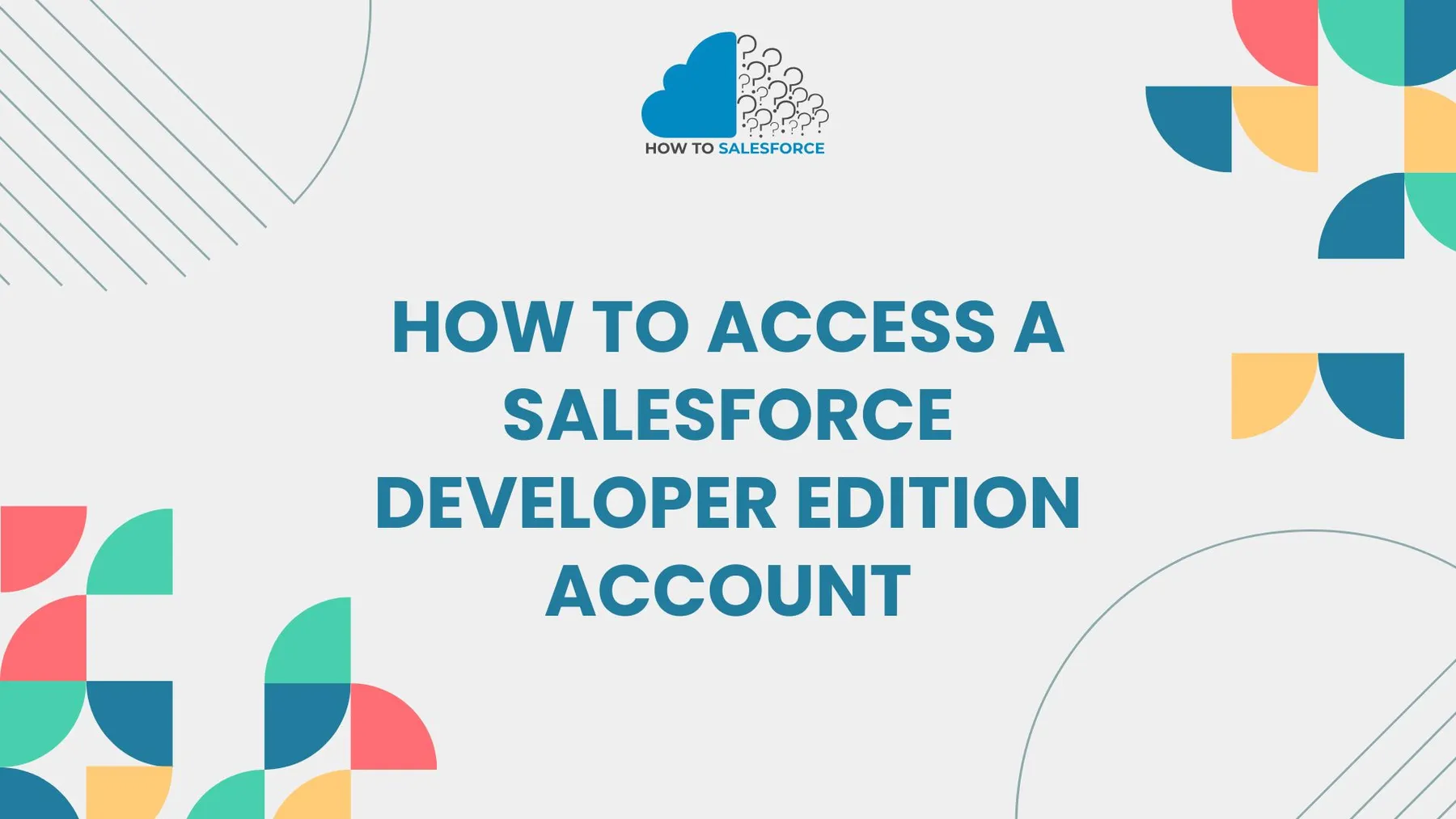Introduction
For learning, development, and testing, Salesforce offers a Developer Edition account. It allows users to test out Salesforce features without taking any risks. We’ll go over how to access a Salesforce Developer Edition account in this article, going over its features, setup procedures, and best practices to help you get the most out of your Salesforce knowledge.
Curious to learn more? Here’s another guide you’ll love: Order of Execution in Salesforce
What is a Salesforce Developer Edition Account
For individual users who wish to study, test, and experiment with Salesforce features without affecting any live environment, there is a dedicated, free account called the Salesforce Developer Edition. Developers, Salesforce administrators, and users seeking a specialized sandbox for skill development or idea testing favor this well-liked tool.
Why Choose Developer Edition
This account is perfect for the following because it offers a variety of Salesforce features, such as data storage, API access, and customization tools:
- Learning Salesforce: Use Trailhead modules and practical experience to examine key features.
- Automation Testing: Create and test automation in a secure setting.
- Building Integrations: Connect external apps using Salesforce’s API capabilities.
- Trying Out Customisations: Make unique fields, objects, and processes risk-free.
Step-by-Step Guide
To establish and access your Salesforce Developer Edition account, start by following these easy steps.
Visit the Salesforce Developer Website
Go to [developer.salesforce.com](https://developer.salesforce.com) to get started. This is Salesforce’s specific resource center, where you can register for a Developer Edition account.
Click “Sign Up”
Find the Sign-Up button on the Salesforce Developer homepage. It is easily accessible because it is typically on the home page. You will be directed to the Developer Edition registration page upon clicking this.
Fill Out the Registration Form
A form with fields for name, email, job role, and company will be displayed to you. Provide accurate information in this form. Salesforce will send you a verification email, so it’s crucial to use a working email address.
- First and Last Name: Give your entire name.
- Email: Type in a valid email address. Salesforce will send activation links here.
- Job Role and Company: Choose the options that most closely correspond to your role. To access the account, you do not need to work for a company.
- Username: Make your username distinct. Even if it’s not a real email address, it should appear to be one. Since Salesforce usernames need to be distinct for every account, you might need to change it if the one you want is already taken.
Submit the Form
Once the form has been filled out, click “Sign Up.” The registration process will be handled by Salesforce and should only take a few seconds.
Check Your Email for Verification
To the email address you supplied, Salesforce will send a verification email. To validate your account, open this email and click the activation link. Since you won’t be able to access your Developer Edition account without verifying it, this step is essential.
Log in to Your Salesforce Developer Edition Account
You are now able to access your account following verification. Proceed to [login.salesforce.com](https://login.salesforce.com) and input the password and username that you created.
Key Features and Functionalities of Salesforce Developer Edition
The Developer Edition account has a robust feature set that is comparable to that of a complete production Salesforce environment. Nevertheless, it has certain limitations and is intended for learning and development.
Objects and Data Management
Salesforce’s core objects, including Accounts, Contacts, Leads, and Opportunities, can be created and managed with the Developer Edition. To meet particular needs, you can also make custom objects.
- Standard Objects: These consist of essential Salesforce items such as Leads, Contacts, and Accounts.
- Custom Objects: Create items that are unique to your needs to personalize your surroundings.
API and Integration Access
The REST and SOAP APIs are accessible through Salesforce Developer Edition, facilitating system integration. For developers working on custom apps or integrations, this is a great feature because it allows you to practice making API calls without running the risk of production failure.
Process Automation Tools
Salesforce’s automation features, such as Process Builder, Flow, and Workflow Rules, are available to you with Developer Edition. These tools increase productivity by streamlining tedious tasks.
- Process Builder: Use criteria-based triggers to automate tasks.
- Flow: Create intricate automation with a higher level of personalization.
- Workflow Rules: Configure fundamental automations according to actions and criteria.
Lightning App Builder
You can create custom pages with Lightning App Builder’s drag-and-drop interface. With the help of this tool, which is available in the Developer Edition, you can customize an interface without having to know a lot of code.
Security and Permission Management
With Salesforce’s strong security features, users may manage access through roles, profiles, and permissions in the Developer Edition account.
- Permission Sets and Profiles: Assign roles to regulate data access levels.
- Field-Level Security: Limit access to and editing authority for specific fields.
- Role Hierarchies: Establish hierarchies for efficient data organization and security.
Optimizing Your Salesforce Developer Edition Account
Effectively configuring your Developer Edition environment is crucial after initial setup. By following these steps, you can optimize your workflow and increase your productivity.
Configure API Access
If you intend to work with integrations, make sure that you have access to your API. To modify API permissions, navigate to Setup > App Manager.
Set Profile Settings
Make your profile settings unique to your requirements. For a more user-friendly experience, change settings like currency, language, and time zone.
Install Useful Apps from AppExchange
To increase functionality, Salesforce’s AppExchange provides a selection of both free and premium apps. Report generators, field management tools, and data loaders are examples of common tools.
Essential Best Practices for Using Developer Edition
You can make effective use of the Salesforce Developer Edition by following these best practices:
Use Sample Data
Sample data allows you to safely experiment without using real customer information. Use Salesforce’s data import tools to load sample data quickly.
Backup Your Data Regularly
Maintaining regular data backups guarantees that your progress is never lost. Export important objects into CSV files or use Salesforce’s data export features.
Experiment with Automation Carefully
Starting simple and introducing complexity gradually is the best approach because automation can affect other users. Prior to putting workflows or automation into place, make a plan.
Engage with the Salesforce Community
Excellent resources are offered by the Salesforce community, including webinars, Trailblazer communities, and forums. You can stay current, exchange ideas, and solve problems by interacting with the community.
Troubleshooting Common Issues in Developer Edition
Even though Developer Edition accounts have many benefits, users may occasionally run into problems. Here’s how to deal with the most typical ones:
Password Reset
Click Forgot Password on the Salesforce login page if you can’t remember your password. Salesforce will assist you with the reset.
Account Lockouts
After several unsuccessful tries to log in, Salesforce may temporarily lock your account. If this occurs, reset your password or wait for approximately fifteen minutes.
Page Load Issues
Try refreshing and checking your internet connection if pages are not loading properly. Clearing the cache in your browser can occasionally fix display problems.
Conclusion
Gaining knowledge of how to access a Salesforce Developer Edition account opens up enormous possibilities for learning, experimenting, and growth without the dangers of a live setting. With the aid of this useful tool, you can become proficient with Salesforce, investigate more complex features, and become at ease with automation and customization. Get started with Salesforce right away and develop your abilities with the Salesforce Developer Edition.


